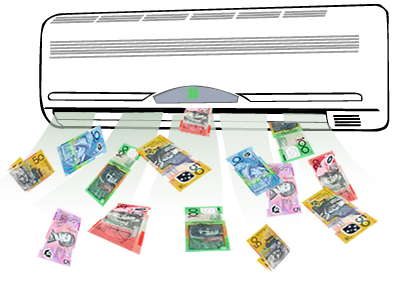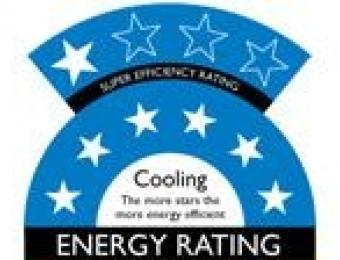Determining the cost of cooling and heating is quite difficult, because it’s really not as simple as just figuring out what you spend per month on power. That’s really only a small piece of the puzzle.

If you want to do it properly, you also need to consider the initial outlay for your heater or airconditioner, installation costs, maintenance costs, peak and off-peak electricity rates, the cost of gas or firewood, and how often you use the system.
Rough estimates
While it’s difficult to pin down an exact figure for this (especially as you’re unlikely to have your aircon or heater on for the same amount of time every day), there are some basic calculations you can do to estimate your costs. To make a rough estimate of your electricity usage, you need to know the following:
1. How much you pay per kilowatt hour for electricity. Your most recent electricity bill should tell you this. If you are on a plan that provides peak and off-peak rates, you need to calculate these figures separately.
2. How many kilowatts the airconditioner or heater uses. If it’s a 2000W appliance, that’s 2 kilowatts. You can find the rated power consumption for your aircon or electric heater either by checking in the manual, or on the manufacturer’s website.
3. How many hours you use it for over a set period. In this instance, we’ll say a year.
A very basic set of calculations for an electric heater or airconditioner looks like this:
Total power cost per year
Hours used per year
x Rated power of aircon/heater in kilowatts
x Cost per kilowatt hour (kW/H)
= Total electricity cost per year
You also need to remember that the energy used by your airconditioner or heater might vary vastly between full-power and economy modes. If you only ever use low-power mode, you would calculate for the amount in kilowatts that your appliance uses in that mode. If you use gas, you can adapt the above equation to calculate how many units of gas you use, and how much that costs.
For the sake of argument, let’s also factor in the cost of buying, installing and maintaining the airconditioner or heater. Let’s assume that it’s going to last 10 years, and that you’ll only need to service it once in that time:
Total cost per year
Total electricity cost per year (years)
+ Overall cost of installation/10 (years)
+ Cost of one maintenance visit/10 (years)
= Total cost overall for one year
Ways to spend less
Every degree you change your air conditioning has an impact on your power bill. The recognised and recommended temperature to set your thermostat to is 24° Celsius, and every degree you move under that can actually add up to 15% to your running costs as well as require more maintenance.
Also, every time you adjust the temperature it requires electricity to respond, so you should pick a temperature and stick with it. If your airconditioner has an economy mode, using that may drastically improve your energy consumption. You should also close any curtains or blinds you have, to prevent unwelcome heat gain or loss.
It is also important to match the capacity of the unit to the capacity of your room. If the unit is too big for the room, it will use an excessive amount of energy. Similarly, if the unit is too small, it will also use an excessive amount of energy as well as struggle to deal with temperature extremes. Possibly the best ways to spend less on electricity is to install photovoltaic solar panels on your roof, and generate your own electricity. Solar panels work best on sunny days, and are an ideal way to offset your airconditioner usage.
Energy efficiency ratings
Every air conditioner made in or imported to Australia since 1987 is subject to Minimum Energy Performance Standards (or MEPS), which is a system that works to ensure that only the most efficient products are available to the Australian market.
In April 2010, new labelling requirements came into play and air conditioners and heaters can now hold up to a 10 star rating. Heating systems also come with energy efficiency labels.
The cost of ceiling fans
Ceiling fans offer an energy-efficient option for keeping your home feeling up to eight degrees cooler during summer. Most ceiling fans only use about the same amount of power as a 60W light bulb (compared to an average air conditioner at 2000W). This also makes ceiling fans very affordable to run, typically costing less than one cent per hour.
If you still prefer airconditioning, you can further reduce your power bills by using ceiling fans in tandem with air conditioning. This technique can reduce air conditioning bills by up to 40% - although obviously it’s going to cost considerably more to install and maintain both technologies.





